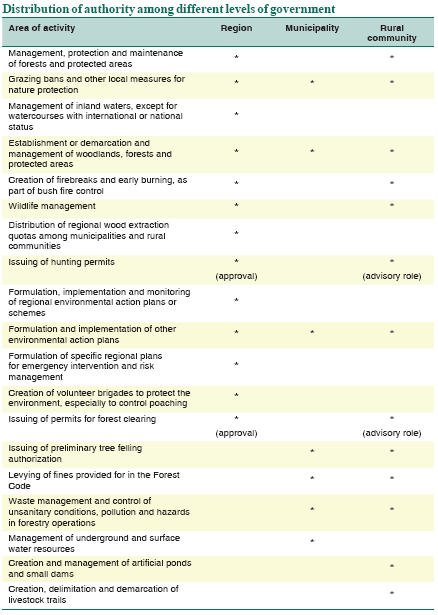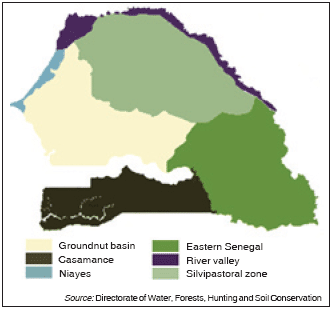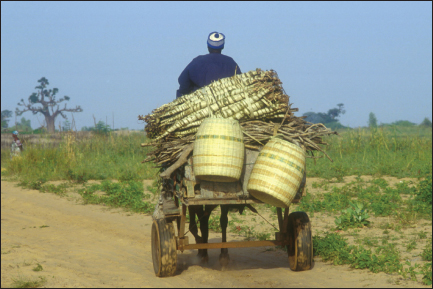O. Diaw
Senegal’s national forest programme emphasizes capacity building within
a decentralized institutional framework for effective implementation of
programmes to curb desertification, deforestation, forest and soil degradation
and biodiversity loss, while also targeting livelihood support and poverty reduction.
Omar Diaw is Water and Forestry Expert, National Focal Point for the National Forest Programme, Directorate of Water, Forests, Hunting and Soil Conservation, Dakar, Senegal.
The role of Senegal’s central government changed as a result of sweeping reforms carried out in the 1990s which introduced a new decentralized administrative structure. With many forest management responsibilities shifted to regional and local institutions and communities, a key role of the national forest service is to boost decentralized capacities for planning and management.
This article describes the process of decentralization in the forest sector, the distribution of authority for natural resource management, and the achievements and ongoing activities of the national forest programme – with support from the National Forest Programme Facility – in pursuit of sustainable forest management for the whole country.
Senegal has a semi-arid Sahelian climate. Although rainfall varies considerably from year to year, in general it has been declining for about 30 years. Years of drought have contributed directly to a degradation of natural resources.
Apart from the unfavourable climate in most of the country, human activities have also had negative impacts on forest resources, for example through frequent bush fires which degrade soil already impoverished by inappropriate farming practices, overgrazing connected especially with transhumance, extensive livestock rearing, unsustainable fuelwood extraction and illegal cutting in the most densely wooded areas (often provoked by poverty) and agricultural clearing and farming within reserved forests. The result is loss of biological diversity, forest degradation and decline in production of wood and non-wood forest products. Forest cover has receded by an estimated 45 000 ha per year since 1990 (FAO, 2006).
Classified forests, reforestation and rehabilitation areas, strict natural reserves, special reserves and national parks, which cover more than 6 million hectares accounting for 31.7 percent of the country, are managed by the national forest service (the Directorate of Water, Forests, Hunting and Soil Conservation) and the Directorate of National Parks, both in the Ministry of Environment and Nature Protection, with decentralized structures having an important role. Protected forests not included in the classified category are managed by local communities.
The forest resource conservation policy begun during the colonial period and maintained after independence in 1960 referred exclusively to the responsibilities of the national forest service, created in 1935. The national forest service carried out activities related to forest protection, grazing bans and forestry operations in the dry zone and reforestation and enrichment in closed forests, while severely enforcing a restrictive Forest Code that greatly limited people’s use of forest resources.
The 1981 Forest Development Master Plan and the 1993 Forest Action Plan, created with the assistance of FAO, facilitated the introduction of changes that would enable Senegal to address the issues and challenges addressed in the international conventions adopted at the 1992 United Nations Conference on Environment and Development (UNCED) – including deforestation, land degradation, lack of fuelwood and domestic energy and biodiversity loss.
The legal framework for forest management was revised with a new Forest Code, adopted in 1995, comprising the Forest Law and its companion Regulation. It was designed to stimulate a participatory approach in natural resource management. New approaches fostering community, village and private reforestation efforts and emphasizing the training of the local population have been strongly encouraged. Furthermore, actors and institutions dealing with forestry are now more open to input from other disciplines such as economics, agriculture, livestock raising and pastoralism, and sociology and rural outreach.
These approaches have made it possible to motivate the local population to dedicate time and energy to the development, protection and rehabilitation of forest resources. Further incentive has been provided by projects and programmes funded through bilateral and multilateral cooperation with many countries. For example over three decades of cooperation with Senegal, FAO has assisted the implementation of at least 25 forestry projects covering such areas as planning, training, forest management, forest protection, public participation, community forestry, wildlife management and forest inventory.
However, the greatest transformation has been the decentralization of forestry administration. In 1996, building on a long tradition of peace, freedom, institutional stability and democracy, and seeking good governance and transparency in State affairs, the Government of Senegal undertook a thorough institutional reform with a view to establishing local communities as the main actors and real decision-making centres. The new administrative structure transferred authority to new regional and local government bodies, extending power to 11 regions, 110 municipalities, 43 districts and 320 rural communities. These decentralized bodies were given nine areas of responsibility: public land, health/population and social action, education, urbanization and habitat, youth/sport/leisure, land- use planning, culture, planning, natural resources and environment. This reform drastically changed approaches to forest administration and management.
 |
| Ecogeographical zones of Senegal |
 |
The 1996 reform led to an enlargement of the1993 Forest Code to cover a broader domain. Major innovations in the new code of 1998 included:
Within their administrative and/or geographical boundaries, the decision-making bodies, especially regional, municipal and rural community councils, each headed by a president elected through universal suffrage, received new powers in addition to those granted at the time of their creation (see Table).
The transfer of authority in natural resource and environmental management, as in all nine areas of responsibility listed above, is based on the general principle of freedom and proximity (devolving freedom in decision-making to elected local people or decentralized authorities well connected to their base) and the following specific principles:
An evaluation of decentralization in natural resource and environmental management (Wade, 2004) revealed that a number of factors limit local communities in assuming their role satisfactorily:
The institutional arrangement for decentralization anticipated capacity-building for elected officials and harmonization of the various local and regional plans (e.g. the Regional Integrated Development Programme, the Regional Land Use Plan, the Municipal Investment Programme and the Local Development Plan). National economic plans support this set-up, channelling resources through regional development agencies created in each of the country’s eleven administrative regions. These agencies have a crucial role in coordinating and mobilizing local institutions and resources and are strong examples of effective decentralization in action.
Within this framework, the national forest service has an advisory and supporting role for local communities, focusing particularly on:
| Senegal’s recently approved National Forest Policy revises the earlier Forest Action Plan to address poverty reduction as well as environmental sustainability (villager on his way to the local market with medicinal plants from the forest) |
 |
| FAO/CFU000199/R. Faidutti |
It is vital that activities initiated by projects and programmes can be continued by the beneficiary populations on their own. Unfortunately this is not always the case. With this concern in mind, Senegal decided to revise its Forest Action Plan, which had allowed sizable investments in the forest sector, to bring it into line with the Poverty Reduction Strategy Paper, the United Nations Millennium Development Goals, the UNCED agreements and the new decentralized institutional framework. The new National Forest Policy links the two themes of decentralization and poverty reduction.
The policy was elaborated through a bottom-up planning process involving all stakeholders and institutions dealing with natural resources management. It includes a diagnosis of problems, defines a long-term vision, gives principles for operations, defines strategies and orientations and lists priority projects and programmes.
In the revision of the Forest Action Plan, the national forest service received essential support from the National Forest Programme Facility. The Facility signed a letter of agreement with the Directorate of Water, Forests, Hunting and Soil Conservation in April 2003 to support and consolidate Senegal’s National Forest Policy. In its first phase, this partnership assisted the formulation of five regional forest action plans and provided funding for national workshops on the launching and implementation of the new forest policy and for studies on Senegalese forestry. These studies included, inter alia, an analysis of public spending in the forest sector; the impact of the Forest Action Plan on wildlife; the efficacy of decentralization and transfer of powers in natural resource management; and the contribution of forest products in the Special Programme for Food Security, FAO’s flagship initiative for halving the number of hungry people in the world by 2015.
In Phase II (2004–2007), the Facility proposed that civil society organizations should have a more decisive role in the national forest programme. For transparency in project selection, a national committee made up of representatives of State structures, local communities and non-governmental organizations (NGOs) selected the best projects from those received in response to a call for proposals. The main themes of the ongoing activities are:
Activities have included numerous training workshops targeting a great variety of stakeholders, from local elected officials, business and religious leaders, representatives of community organizations and NGOs to policy-makers and government officers.
| Studies supported by the National Forest Programme Facility have included an analysis of the contribution of forest products in FAO’s Special Programme for Food Security – which included small-scale projects on apiculture, for example |
 |
| FAO/22112/J. Koelen |
First under the Forest Development Master Plan, then the Forest Action Plan and now the National Forest Policy, Senegal with the support of international cooperation has devised and implemented major programmes and projects to combat desertification, curb the negative trend of biodiversity loss and soil degradation, and generally improve people’s livelihoods.
The national forest service, along with the other services of the Ministry of Environment and Nature Protection, has undertaken about 30 natural resource management projects and programmes in the six ecogeographical zones, in partnership with local people and communities, which have had a positive impact on the environment, natural resources, people and institutions. Examples of successful projects that are meeting the expectations of development partners and the needs of local populations include:
Furthermore, with the assistance of the Government of the Netherlands, the Ministry of Environment and Nature Protection is testing a new planning tool, the Medium-Term Expenditure Framework. Under this framework planning is carried out every three years and includes a clear statement of objectives; the expected results; the definition of programmes, projects and activities; the identification of the institutions or organizations responsible for undertaking the activities; the time frame; and performance indicators to monitor progress. This tool, after testing, evaluation of its advantages and disadvantages, and inclusion of any necessary improvements, is expected to provide better directing of resources to essential activities.
Senegal’s national forest programme is based on a well-designed planning process, the support of government officials, the funding and assistance of many countries and international agencies such as FAO, and the collaboration of all actors or stakeholders, including populations and local communities, NGOs, forest industries, professional organizations, private forest investors and others. Although the total numbers of projects and programmes have declined through time, the State has put a strong emphasis on environmental protection and natural resources conservation and management.
With the decentralization reform, the Government of Senegal took decisive steps to give local governments (rural communities, mayors, regional councils) powers to take matters of natural resources conservation and environmental protection into their own hands by devolving to them the power to make decisions and take action. Senegal’s national forest programme is building capacities to enable them to carry out their role effectively, while linking decentralization to poverty reduction and socio-economic development.
![]() Bibliography
Bibliography
FAO. 2006. Global Forest Resources Assessment 2005 – progress towards sustainable forest management. FAO Forestry Paper 147. Rome.
Wade, W. 2004. Rapport de synthèse national. Report for UNDP Drylands Development Centre (DDC) study on decentralized governance of natural resources. Available at: drylandsnetwork.undp.org/extra/docs/SENEGAL%20GCF-GOVERNANCEL%20REPORT.doc